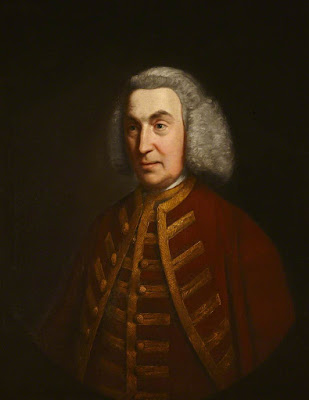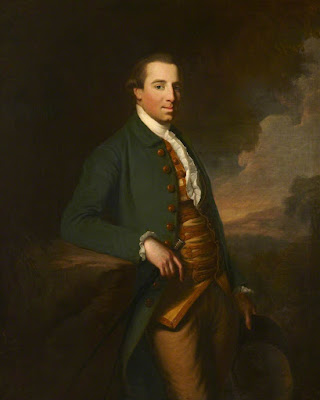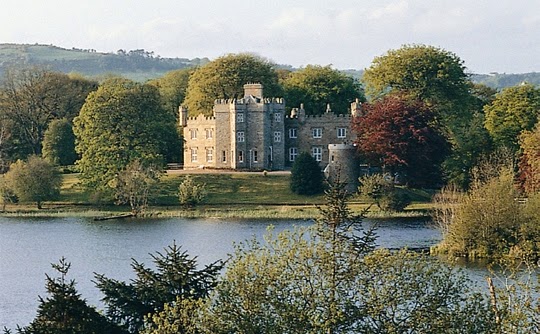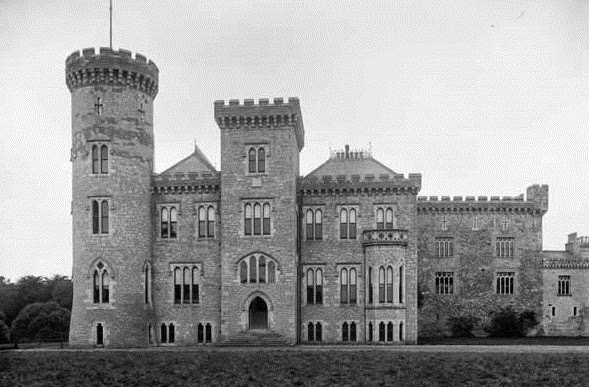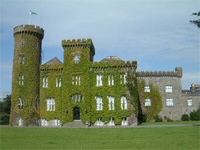It lies across the entrance of Sandy Bay, the place where we departed on the 7th July, 2018, for our trip to the tiny island.
In fact Ram's Island used to be considerably tinier, because the water level of the lough has been lowered by about eight feet since 1847.
Prior to 1847, the island extended to a mere six acres; whereas today it comprises over forty acres, a cause of some debate between the owner of the island and the owner of the lake-bed.
This little islet was greatly beautified in the 18th century by a previous owner, James Whittle, who planted a profusion of shrubs and trees, laid out an orchard and a garden, and maintained it all most assiduously.
The short journey from Sandy Bay to the island takes less than ten minutes.
We embarked on the good boat Island Warrior and motored across the stretch of water (which occasionally froze over in the past) to a large jetty, where we all disembarked.
There is an old barge adjacent to the jetty, used as a kind of visitor centre for catering and so on.
Refreshed with a good beaker of tea and a bun, we were given a tour by our guide, Michael Savage, who showed us the ancient round tower and the ruins of Lord O'Neill's former cottage.
I should mention that the stump of the tower, about forty-three feet in height, thirty feet in circumference, stands among tall trees.
Its walls are almost three feet in thickness.
This charming islet is a haven today for doves, ducks, blackbirds, finches, even a few hens!
It had a herd of goats until twenty or thirty years ago.
Ram's Island had a monastery in the 11th century, which was seemingly destroyed or plundered by a local tribe in 1121.
Una Brankin wrote an interesting article in 2013 about life on Ram's Island and its resident caretakers.
| Lord O'Neill's Cottage (Image: Timothy Ferres, 2018) |
Charles, 1st Earl O'Neill, purchased the island in 1804 for £1,000 (about £95,000 today) and erected a singularly pretty and tasteful cottage.
The 1st (and last) Earl never married. He spent a great deal of time on Lough Neagh, and in a number of cottages which he built at various points in and around the lough. He kept several yachts, including one of the very first steam-powered vessels.Lord O'Neill adopted it as his occasional residence, and converted the island into a most luxurious demesne.
The entire ground was laid out into walks, and covered with lush green flora.
Several hundred rose trees, exquisite plants and flowers all thrived luxuriantly.
Even those sides of the island which were almost perpendicular were adorned with all those creeping plants and hardy shrubs which were suitable for the location.
The 1st and last Earl also built a resident caretaker's residence.
Lord O'Neill's cottage stands almost directly below the round tower, the remains of which still dominate its roofless shell today.
It was maliciously burnt to the ground in 1944, some seven years after the last caretaker had left the island.
The O'Neill coat-of-arms proudly adorned the front of the cottage overlooking the lough, between two gothic windows, though I examined the walls myself and absolutely nothing remains today to indicate its existence.
There is still some plasterwork inside, though scorch-marks betray the ferocious fire which engulfed the cottage over seven decades ago.
| Pebble-dashing (Image: Timothy Ferres, 2018) |
It was pebble-dashed, with a very wide, overhanging thatched roof.
This history aroused my interest to the extent that I wrote a bit about the cottage some years ago.
In 2005, Lord O'Neill signed a thirty-year lease with the River Bann and Lough Neagh Association for the custodianship of the island.
During our tour I asked Michael if the O'Neills still had photographs of their times on the island, though he explained that in 1922 the Victorian Shane's Castle had been maliciously burnt, thus destroying all mementoes and Victorian photographs.
Lord O'Neill remarked that their first priority, naturally, had been to save valuable works of art, furniture and so on, and the likes of photographs perished.
So if any readers possess old images of Ram's Island in their attics or lofts, send them to me, please, for publication on the blog.
Our island trip concluded at about three-thirty in the afternoon, and we left a dozen or so campers outside their tents nestling in the woods.
First published in July, 2018.













